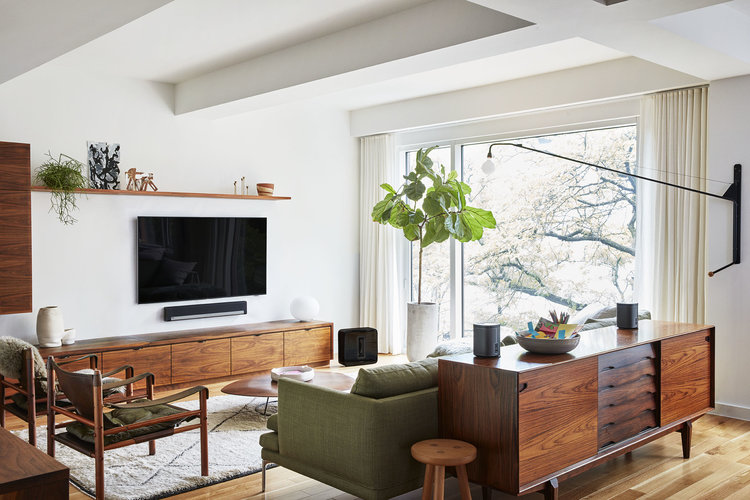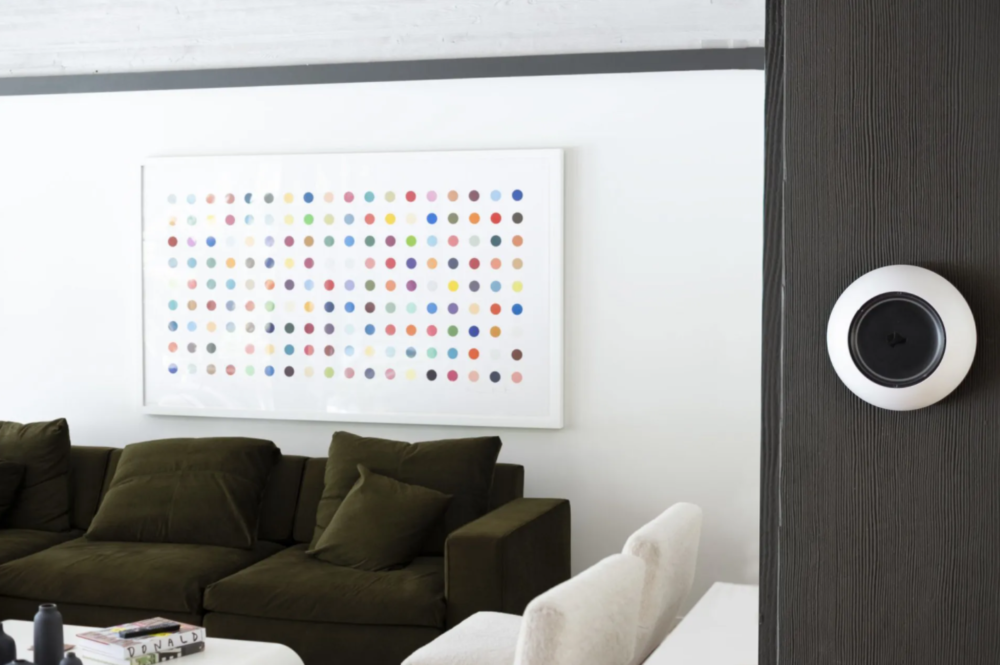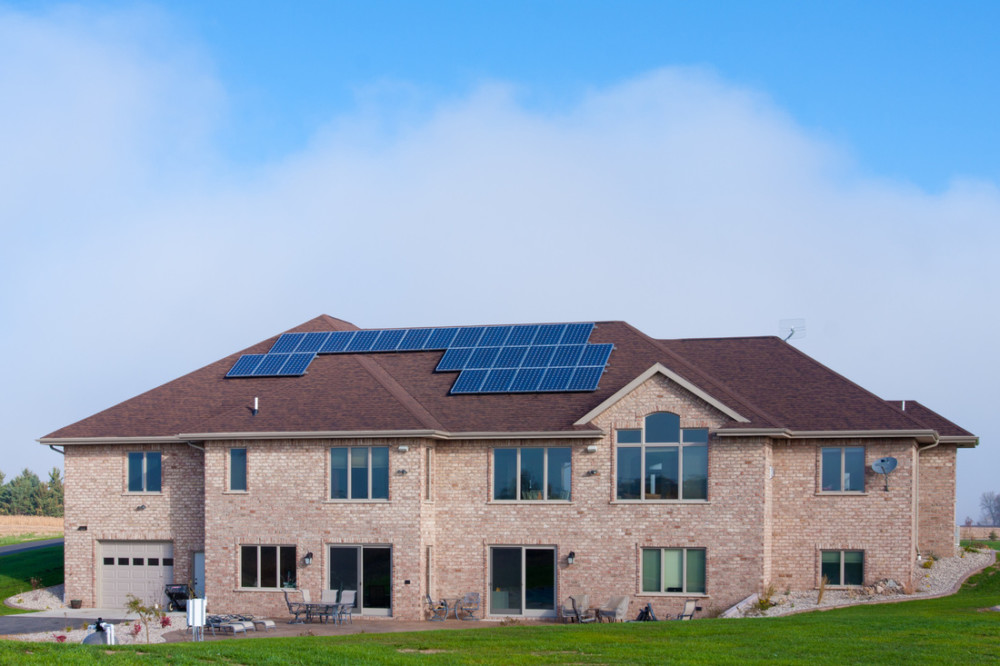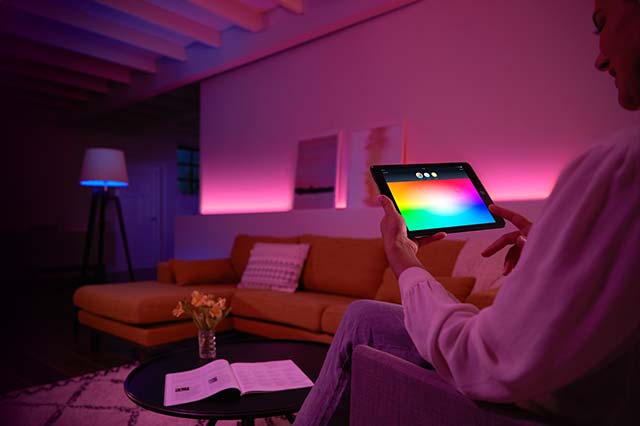Home IQ
Smart home technologies increase functionality, save energy and create a seamless living environment
The definition of a smart home has evolved as consumers’ interests have become more demanding. Smart home devices are designed with convenience in mind and aim to make home life more efficient. A wide variety of smart home technology exists, and in recent years, consumers have begun to utilize these products through the purchase of voice control technology, automated lighting systems and doorbell cameras, among many other options.
At the same time, COVID-19 has forced people to adapt to spending more time at home. Many homeowners are now interested in installing smart home technology to modernize their dwellings, making them more conducive to work and life.
Keeping up with the latest solutions to smart home technology may seem overwhelming, but it doesn’t have to be. Businesses in the Fox Valley that specialize in home improvements make it a priority to cater to their customers’ needs.
Compared to the newest smart home products, security systems have been in existence for the longest and exist in many forms, ranging from cameras to alarm systems. TECC Security Systems in Neenah offers solutions to home security. Their systems allow homeowners to arm and disarm systems, be notified when someone is at the door and lock doors all from their smartphone. If there is a detection of a home intrusion, authorities will quickly be notified and dispatched.
Dave Fontecchio, owner of TECC Security Systems, can attest to the benefits of home security systems. 
“The alarm sends notifications in instances when somebody walks into the living room, when the gun cabinet or liquor cabinet is opened. If you forgot that somebody has to get into your house and you are gone, you can unlock the door and disarm the system from your phone or your computer,” he explains.
Consumers have the option to connect their systems to Z-Wave, a reliable form of radio frequency. This is an improvement over using Wi-Fi controlled systems, as these tend to prevent security and home automation features from working when a home’s internet goes out.
TECC’s security systems are designed with government-grade encryption, essentially meaning that nobody can hack into it. The most common installation that TECC offers is a traditional security panel, but an extensive list of home automation features is available and are controlled through the homeowner’s smartphone. Home automation means that parts of a home—including lighting, thermostat and locks—are automatically controlled by a system and can be managed through a smartphone. The status of these can be fully monitored and managed from one’s smartphone, no matter how far away that person is from their home. These home automation features are seamlessly integrated into one’s home without disrupting its visual appeal.
A recent trend in home security that Fontecchio offers is the installation of exterior sensors, primarily on properties in rural areas with long driveways. Mainly used by residents who are unable to see their driveway from inside, these sensors are triggered when a car enters their property. When this occurs, the outdoor lights turn on, thus alerting the homeowner of an unwanted guest.
Fontecchio also gives customers the option to hardwire cameras to the exterior and interior of their homes. The camera footage can be streamed on a smartphone and can display a view of an entire room.
With the introduction of voice controlled systems, such as Amazon Alexa, many consumers are turning to systems like these to make hands-free commands. Evolved Habitat, a home automation company based out of Green Bay, offers a system called Josh.ai.
Josh is an automation system programmed into a home and is used to answer voice commands. These voice commands range from changing the temperature to turning on speakers or changing the lighting. All features that can be changed through commands are also changeable on connected smart devices. Any type of smart device, including smartwatches, can be connected to Josh. The system is programmed to recognize natural, conversational ways of talking; there is no need to speak a certain way to make a command.
As a whole, Josh creates an efficient lifestyle for consumers, not only because all of a home’s smart features are grouped together but also because they can be used through simple voice commands. The ease of controlling one’s thermostat and lighting, for instance, can also be a factor in energy efficiency and savings.
While many consumers are interested in the functionality aspect of their homes, many make it a priority to have top-of-the-line entertainment systems as well. One popular option is the Sonos system, which is a speaker system that connects to your home Wi-Fi, allowing homeowners to stream music from virtually every platform including Pandora, Spotify and Apple Music—there are over 150 apps to choose from when streaming music through Sonos. Music can be streamed on iPhones, Androids, tablets and computers.
“Sonos is a very manageable system,” explains Josh Martin, sales manager at Sound World in Appleton. “It is easy to integrate into different scenarios, making it a very customizable solution to home entertainment.”
The customizability continues during the installation process. Residents can install speakers into their ceiling and walls or simply keep them as external features on top of cabinets or shelves. Speakers can even be installed on the exterior of homes, extending entertainment opportunities to a home’s backyard.
In addition to streaming music, Sonos can also be programmed as a 3D surround sound system when watching television. “This option creates a theater experience with little equipment. It’s a simple TV solution,” Martin says.
Although most commonly used for these reasons, smart home features can extend beyond security and entertainment purposes. Ingrid Nahm, co-owner of Appleton Solar, says that smart solar systems can contribute to energy efficiency and savings.
“Homes with solar panels generate their own electricity,” Nahm says. “Although most of these homes still use power from the electrical grid, the focus is on reducing how much of that power you need.”
Appleton Solar installs photovoltaic solar panels—devices that produce energy from sunlight—in both residential and commercial settings. In addition to solar panels, Appleton Solar also installs Tesla Powerwall batteries, which store the energy produced from the solar panels. Energy is, therefore, more readily available and can be accessed when the sun goes down or when the electrical grid is temporarily unavailable. These solar systems allow homeowners to monitor energy consumption; residents can see how much energy their home is making and using through their smartphone. Since the system is app-driven, residents can choose to stop using the powerwall and use energy from the grid or the solar panels, and vice versa. Customers have complete control of where their power is coming from at any given time.
The financial benefits of solar energy are what draws consumers in. Residents with solar panels are eligible for federal tax credits due to the use of renewable energy. Nahm explains that 22 percent of the installation cost can be claimed in federal tax credits for the year you choose to install it. This applies to solar parts, installation costs and the Tesla Powerwall. Residents are also eligible for a $500 cash reward for choosing to use solar energy.
Nahm justifies the purchase of renewable energy systems as an investment. The lifespans of photovoltaic solar panels are typically 30 or more years. These renewable energy systems ultimately increase the overall value and appeal of a home. In comparison to nearby homes, a lower energy bill increases the resale value of a home with renewable energy technology.
Smart home technology has significantly expanded its capabilities within the last decade. The endless amount of available systems proves that one’s home is truly customizable, whether the priority is to ensure home safety, stream music throughout the entire house or reap the financial benefits of renewable energy.
More Smart Home Features
- Smart lighting
- The Philips Hue system is made up of energy-efficient LED lights that come in multiple variations to fit your home. The smart hub connects the lights to your smartphone, allowing you to control the lighting on the Philips Hue app.
- Smart thermostat
- Ecobee offers ENERGY STAR approved thermostats that can be controlled through a smartphone. These thermostats can automatically adjust the temperature to save electricity and can also follow a programmed schedule to suit the homeowner’s preferences.
- Motorized shades
- MySmartRollerShades are programmed to meet the needs of the homeowner. These interior shades can automatically open and close when the sun rises and sets and can also follow a programmed schedule. MySmartRollerShades are also controllable through bluetooth-enabled devices.
- Video doorbell
- Google’s Nest Hello takes the place of a traditional doorbell by adding a camera capable of streaming HD video. Live footage—as well as three hour old footage—of your front door can be streamed on your smartphone.
- Smart speaker
- Amazon Echo functions through voice commands , allowing homeowners to stream music without reaching for their devices. Not only can you request music, but you can also ask about the weather or what is on your digital calendar.














Leave a Comment